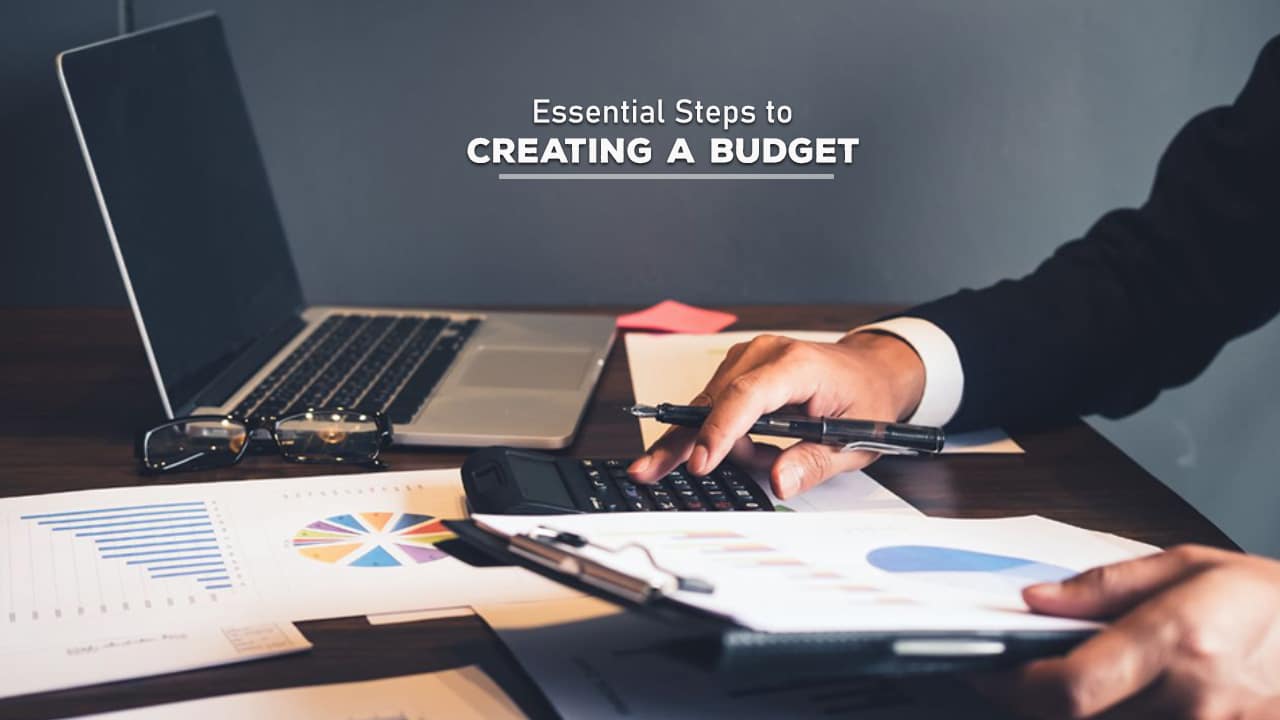Creating a budget is a smart way to take control of your money. It helps you see where your cash goes and plan for the future. A reasonable budget can make your financial dreams come true. Budgeting is the key, whether you want to save for a big trip or pay off debt.
Getting started with budgeting might seem complicated, but it doesn’t have to be. You can make a budget that works for you with simple steps.
This guide will show you how to create a budget for your life and goals. You’ll learn easy ways to track your spending and save more money.
1. Assess Your Financial Situation
Looking closely at your money is the first step in making a budget. You need to know where you stand before you can make a plan.
Start by adding up all the money you make each month. This includes your paycheck and any other income you get.
Next, make a list of everything you spend money on. Write down your rent, mortgage, bills, food, and other expenses. Don’t forget things like streaming services or gym memberships.
Now, subtract your expenses from your income. This shows if you’re spending more or less than you make. If you’re spending more, you must find ways to cut back.
Look at your bank statements and credit card bills. They can help you see where your money is going. You might find some surprises.
Think about your financial goals, too. Do you want to save for a big purchase? Pay off debt? Build an emergency fund? Knowing your goals will help shape your budget.
By taking these steps, you’ll get a clear picture of your finances. This knowledge is critical to creating a budget that works for you.
2. Categorize Your Expenses
Grouping your expenses into categories helps you understand where your money goes. Start by looking at your recent bank statements and credit card bills. Make a list of all your spending.
Next, create categories that make sense for you. Common ones include housing, food, transportation, and utilities. Don’t forget about entertainment, personal care, and savings.
Go through your list and assign each expense to a category. This process shows you which areas take up most of your money. It also helps spot places where you might be overspending.
Be specific with your categories. Instead of just “food,” use “groceries” and “eating out.” This gives you a clearer picture of your habits.
Remember to include irregular expenses like car repairs or holiday gifts. These can catch you off guard if not planned for.
Once you’ve sorted everything, add up the totals for each category. This gives you a snapshot of your spending patterns. You can use this info to set realistic limits for each area in your budget.
3. Set Clear Financial Goals
Setting clear money goals is critical to making a budget that works. Think about what you want to achieve with your money. Do you want to save for a big purchase? Pay off debt? Build an emergency fund?
Write down your goals. Be specific about how much money you need and when you want to reach each goal. This helps make your goals real and gives you something to work towards.
Break big goals into smaller steps. Set monthly savings targets if you want to save $10,000 for a down payment on a house. This makes the goal feel more doable.
Prioritize your goals. Decide which ones are most important to you right now. Focus on paying off high-interest debt before saving for a vacation.
Make your goals measurable. Instead of saying “save more money,” set a target like “save $200 per month.” This lets you track your progress easily.
Review your goals regularly. As your life changes, your financial goals might, too. Update them to stay on track with what matters most to you.
4. Track All Spending
Tracking your spending is a crucial part of budgeting. You need to know where your money goes to make intelligent choices.
Start by keeping all your receipts. Write down every purchase you make, no matter how small. This includes cash, credit cards, and online payments.
Use a notebook or smartphone app to log your expenses. Many free apps can help you track spending on the go. They often let you sort expenses into categories.
Check your bank and credit card statements regularly. Look for any charges you don’t remember making. This can help you spot errors or fraud.
Be honest with yourself about your spending habits. Don’t leave anything out, even if it makes you uncomfortable. The goal is to get an accurate picture of where your money goes.
Group your expenses into food, housing, transport, and entertainment categories. This makes it easier to see patterns in your spending.
Add up your expenses in each category at the end of each month. Compare this to your income. You might be surprised by what you find.
Use this information to adjust your budget as needed. You may find areas where you can cut back or save more.
5. Create an Emergency Fund
An emergency fund is a safety net for unexpected expenses. It can help you avoid debt when surprises happen.
To start your emergency fund, set a clear goal. Aim to save 3-6 months of living expenses. This amount can cover most financial emergencies.
Open a separate savings account for your emergency fund. This keeps the money separate from your everyday spending.
Start small if you need to. Even $500 can help with minor emergencies. You can build up from there over time.
Set up automatic transfers to your emergency fund. This makes saving easier. You can start with just $25 or $50 per paycheck.
Look for ways to add extra money to your fund. Use tax refunds, bonuses, or money from selling unused items.
Only use your emergency fund for true emergencies. This might include job loss, medical bills, or urgent home repairs.
Replenish your fund after you use it. This keeps your safety net strong for future needs.
6. Include All Income Sources
When creating a budget, you need to account for all the money coming in, Which means listing every source of income you have.
Start with your primary job. Write down your take-home pay after taxes. This is usually the most significant chunk of your income.
Don’t forget about other jobs or side gigs. If you do freelance work or have a part-time job, add that money too. Every dollar counts.
Think about any regular payments you get. This could be child support, alimony, or social security benefits. Add these to your list.
Remember to include irregular income. If you get bonuses or commissions, estimate how much you typically earn from these each month.
Do you have investments that pay dividends? Or rental properties that generate income? Make sure to add these amounts as well.
Listing all your income sources gives you a clear picture of how much money you have to work with. This helps you make a more accurate and effective budget.
7. Prioritize Debt Repayment
Paying off debt is a vital part of any budget. Start by listing all your debts. Include credit cards, loans, and any other money you owe.
Look at the interest rates for each debt. Focus on paying off high-interest debts first. This saves you money in the long run.
Set aside money each month for debt payments. Make sure to pay at least the minimum on all debts. Put extra cash toward the debt with the highest interest rate.
You should use the debt avalanche method. This means tackling high-interest debts before moving to lower ones. Another option is the debt snowball method. Here, you pay off smaller debts first for quick wins.
Consider ways to lower your interest rates. You could transfer credit card balances or refinance loans. This can help you pay off debt faster.
As you pay off debts, don’t take on new ones. Stick to your budget and avoid using credit cards for unnecessary purchases.
Celebrate your progress as you pay off each debt. This keeps you motivated to reach your financial goals.
8. Adjust for Irregular Expenses
Irregular expenses can throw off your budget. These are costs that don’t happen every month. Think about things like car repairs, holiday gifts, or yearly subscriptions.
To handle these, start by making a list. Write down all your irregular expenses for the year. Add up the total cost. Then, divide that number by 12. This gives you the monthly amount to save.
Create a separate savings account for these expenses. Each month, put aside the amount you calculated. When an irregular expense pops up, you’ll have money ready.
Keep track of when you expect these costs to happen. Mark them on your calendar. This helps you plan and avoid surprises.
Review your irregular expenses regularly. Some may change or go away. New ones might come up. Update your list and savings plan as needed.
By planning for irregular expenses, you make your budget more flexible. You’ll be ready for these costs when they come. This helps keep your finances stable all year.
9. Utilize Budgeting Tools
Budgeting tools can make managing your money much more accessible. You have many options, including apps, spreadsheets, and online services.
Popular budgeting apps like Mint, YNAB, and PocketGuard sync with your bank accounts. They track your spending automatically and sort it into categories. This saves you time and gives you a clear picture of where your money goes.
Spreadsheet programs like Excel or Google Sheets offer more control. You can create custom templates to fit your exact needs. Many pre-made budget templates are also available online for free.
Some banks provide built-in budgeting features in mobile apps or online banking platforms. Check if your bank offers these tools, as they can be very convenient.
Whichever tool you pick, make sure it’s easy for you to use regularly. The best budgeting tool is one you’ll stick with. Try out a few different options to see what works best for you.
Remember to keep your financial information secure. Use strong passwords and enable two-factor authentication when possible.
10. Review Your Budget Regularly
Looking at your budget often is critical. Set aside time each month to check how you’re doing. Are you sticking to your plan? Have your needs changed?
Life doesn’t stand still, and neither should your budget. You may have a raise or have a new expense. Your budget should change, too.
Compare what you spent to what you planned. Did you spend more on groceries than you thought? Or less on gas? Use this info to make your budget better.
If you keep missing your targets, don’t give up. Adjust your budget to be more realistic. Minor tweaks can make a big difference.
Use tools to help you review. Many banks offer spending trackers. Some apps can show your spending patterns. These make it easier to spot areas for improvement.
Remember, your budget is a tool to help you. If it’s not working, change it. A reasonable budget grows with you and enables you to reach your goals.
11. Cut Unnecessary Costs
Trimming expenses is critical to a successful budget. Look for areas where you can reduce spending without sacrificing your quality of life.
Start by reviewing your monthly bills. Can you switch to a cheaper phone plan or cancel unused subscriptions? These small changes can add up fast.
Next, examine your daily habits. Making coffee at home instead of buying it can save you a lot. Packing lunch for work is another easy way to cut costs.
Look for free or low-cost entertainment options. Libraries offer books, movies, and events at no charge. Parks and community centers often have free activities, too.
When shopping, compare prices and use coupons. Buy generic brands for basics like cleaning supplies and medications. They’re often just as good as name brands.
Consider your transportation costs. Can you carpool, use public transit, or bike more often? This can save money on gas and car maintenance.
Energy bills can be lowered, too. Turn off lights when not in use, and adjust your thermostat to use less heating and cooling. These small actions make a big difference.
You’ll have more money for your essential goals by cutting unnecessary costs. Keep looking for new ways to save as you go along.
12. Automate Savings
Setting up automatic savings can help you reach your financial goals faster. It’s a simple way to put money aside without thinking about it.
Start by deciding how much you want to save each month. Look at your budget and pick an amount you can afford. Even small amounts add up over time.
Next, automatically transfer your checking account to your savings account. You can do this through your bank’s website or mobile app. Choose a date that works for you, like right after payday.
Consider using apps that round up your purchases and save the difference. These apps connect to your debit card and move spare change to savings with each buy.
Some employers let you split your paycheck between accounts. Ask if you can send part of your pay straight to savings. This way, you save before you even see the money.
Try setting up multiple savings accounts for different goals. You might have one for emergencies and another for a vacation. Automate transfers to each account.
Remember to review your automated savings plan regularly. As your income or expenses change, you can save more. Or you might need to adjust if money gets tight.
Understanding the Importance of Budgeting
Budgeting helps you take control of your money and reach your financial goals. It gives you a clear picture of your income and spending habits.
Financial Stability
A budget acts as a roadmap for your finances. It shows you where your money goes each month. This helps you spot areas where you can cut back and save more.
With a budget, you can plan for significant expenses. You’ll be ready for things like car repairs or a new roof. You won’t need to rely on credit cards or loans as much.
Budgeting also helps you pay off debt faster. You can set aside money each month to tackle your debts. This reduces stress and saves you money on interest in the long run.
Peace of Mind
Knowing where your money goes brings peace of mind. You won’t worry as much about having enough to cover your bills.
A budget helps you feel more in control of your life. You can make better choices about spending and saving. This leads to less stress about money.
With a budget, you can plan for fun things, too. You can save up for a vacation or a new hobby. This balance between saving and spending makes life more enjoyable.
Budgeting also helps you prepare for the future. You can start saving for retirement or your kids’ college. This long-term planning gives you confidence about what’s ahead.
Budgeting Tools and Resources
Many tools and resources can help you create and stick to a budget, ranging from software to apps to professional advice.
Choosing the Right Budget Software
Budget software helps you track income and expenses easily. Popular options include Quicken, YNAB (You Need A Budget), and Mint. These programs let you link bank accounts and credit cards to auto-import transactions.
Key features to look for:
- Easy-to-use interface
- Customizable categories
- Goal-setting tools
- Bill reminders
- Reports and graphs
Try free trials to find one that fits your needs. Some software has a one-time cost, while others charge monthly fees. Pick one you’ll use regularly.
Utilizing Financial Apps
Mobile apps make budgeting on the go simple. Many are free and sync across devices. Top choices include:
- PocketGuard – Tracks bills and suggests ways to save
- Goodbudget – Uses the envelope method digitally
- Personal Capital – Offers investment tracking too
Look for apps with features like:
- Receipt scanning
- Spending alerts
- Savings challenges
- Debt payoff planners
Read reviews and test a few to see which you like best. Make sure the app is secure before connecting your accounts.
Consulting Financial Advisors
A financial advisor can offer personalized budget guidance. They can help you:
- Set realistic goals
- Create a tailored plan
- Find ways to cut costs
- Plan for big expenses
Advisors may charge hourly rates or flat fees. Some offer free initial consultations. Look for certified professionals like CFPs (Certified Financial Planners).
You can also find free budget help through:
- Bank or credit union workshops
- Non-profit credit counseling agencies
- Community financial education programs
These resources provide expert advice without the cost of hiring an advisor.
Summary
Mastering the art of budgeting is a powerful way to take control of your finances and achieve your financial goals. Following the 12 steps outlined in this guide, you can build a budget that works for your lifestyle and helps you manage your money more effectively.
From assessing your financial situation to setting clear goals, tracking spending, and using the right tools, each step is designed to make budgeting a manageable and rewarding process.
Remember, budgeting is not just about restricting spending but about making informed decisions that lead to financial stability and peace of mind.
With a solid budget, you can confidently plan for the future, handle unexpected expenses, and enjoy the economic freedom of being in control of your money.









































